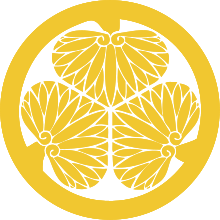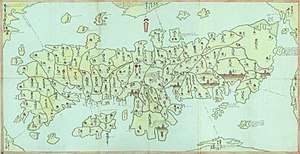Matsue Domain
Matsue Domain (松江藩, Matsue-han) was a Japanese domain of the Edo period. It was associated with Izumo Province in modern-day Shimane Prefecture.[1]
In the han system, Matsue was a political and economic abstraction based on periodic cadastral surveys and projected agricultural yields.[2] In other words, the domain was defined in terms of kokudaka, not land area.[3] This was different from the feudalism of the West.
List of daimyōs
The hereditary daimyō were head of the clan and head of the domain.
- Kyōgoku clan, 1634–1637 (tozama; 240,000 koku)[5]
- Matsudaira (Echizen) clan, 1638–1871 (shinpan; 186,000 koku)[6]
- Matsudaira Naomasa
- Matsudaira Tsunataka[7]
- Matsudaira Tsunachika
- Matsudaira Yoshitō
- Matsudaira Nobuzumi
- Matsudaira Munenobu
- Matsudaira Harusato
- Matsudaira Naritsune
- Matsudaira Naritoki
- Matsudaira Sadayasu
Genealogy

- Yūki Hideyasu, 1st Lord of Fukui (1574–1607)
-



-

-

-

-

-

-

-
-
-
-
-
- Chikayoshi, 1st Lord of Hirose (1632–1717)
- Chikatoki 2nd Lord of Hirose (1659–1702)
- Chikatomo, 3rd Lord of Hirose (1681–1728)
- Nagataka, 4th Lord of Tsuyama (1725–1762)
- Yasuchika, 5th Lord of Tsuyama (1752–1794)
- Naritaka, 7th Lord of Tsuyama (1788–1838)
-

- Naoaki, 11th family head, 1st Count (1865–1940; 11th family head: 1882–1940; Count: cr. 1884)
- Tadakuni, 12th family head, 2nd Count (1902–1988; 12th family head: 1940–1988; 2nd Count: 1940–1947)
- Tadakoto, 13th family head (b. 1925; 13th family head: 1988–)
- Naotada (b. 1966)
- Tadakoto, 13th family head (b. 1925; 13th family head: 1988–)
- Tadakuni, 12th family head, 2nd Count (1902–1988; 12th family head: 1940–1988; 2nd Count: 1940–1947)
- Naoaki, 11th family head, 1st Count (1865–1940; 11th family head: 1882–1940; Count: cr. 1884)
-
- Naritaka, 7th Lord of Tsuyama (1788–1838)
- Yasuchika, 5th Lord of Tsuyama (1752–1794)
- Nagataka, 4th Lord of Tsuyama (1725–1762)
- Chikatomo, 3rd Lord of Hirose (1681–1728)
- Chikatoki 2nd Lord of Hirose (1659–1702)
-
- Yūki Hideyasu, 1st Lord of Fukui (1574–1607)
gollark: I'm down to 937 tabs, so it is probably not that.
gollark: It just consumes more and more RAM until it restarts, eventually.
gollark: I feel like Firefox has memory leak issues of some sort.
gollark: (I rebooted)
gollark: I return.
See also
- List of Han
- Abolition of the han system
References

- "Izumo Province" at JapaneseCastleExplorer.com; retrieved 2013-4-27.
- Mass, Jeffrey P. and William B. Hauser. (1987). The Bakufu in Japanese History, p. 150.
- Elison, George and Bardwell L. Smith (1987). Warlords, Artists, & Commoners: Japan in the Sixteenth Century, p. 18.
- Papinot, Jacques Edmond Joseph. (1906). Dictionnaire d’histoire et de géographie du Japon; Papinot, (2003). "Horio" at Nobiliare du Japon, p. 11; retrieved 2013-4-27.
- Papinot, (2003). "Kyōgoku" at Nobiliare du Japon, p. 27; retrieved 2013-4-27.
- Papinot, (2003). "Matsudaira" at Nobiliare du Japon, p. 30; retrieved 2013-4-27.
- Borton, Hugh. "Peasant uprisings in Japan of the Tokugawa period," Transactions of the Asiatic Society of Japan (1938), p. 46 n31.
- Genealogy (jp)
This article is issued from Wikipedia. The text is licensed under Creative Commons - Attribution - Sharealike. Additional terms may apply for the media files.